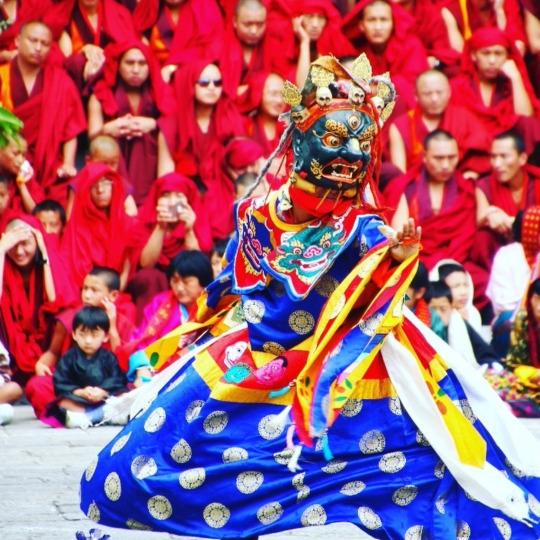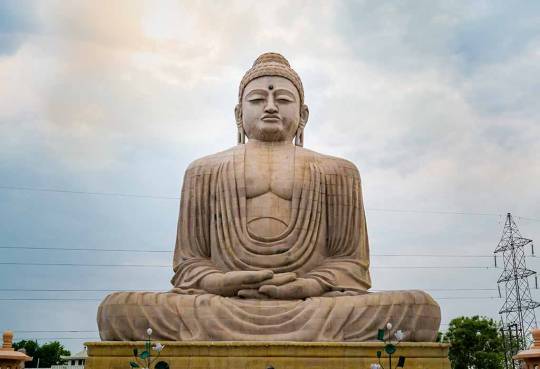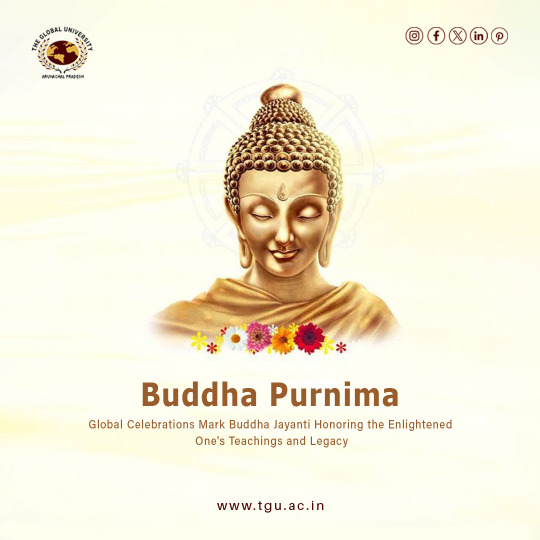#buddhisttradition
Explore tagged Tumblr posts
Text

May the light of Buddha's teachings guide you towards peace and enlightenment. Happy Budh Purnima! 🌕🙏✨
#Monteage#budhpurnima#buddhabirthday#BuddhaPurnima#peace#buddhistfestival#spiritualjourney#innerpeace#mindfulness#compassion#buddhawisdom#meditation#BuddhistTradition#festivevibes#positivevibes#SacredFestival
0 notes
Text



Thiksey Monastery, located in Ladakh, India. It is a prominent Tibetan Buddhist monastery known for its resemblance to the Potala Palace in Lhasa, Tibet. It houses numerous Buddhist artifacts, including statues, paintings and thangkas. It offers stunning panoramic views of the surrounding landscape.
#travel#trousim#photography#ThikseyMonastery#BuddhistRetreat#HimalayanSpirituality#CulturalHeritage#SpiritualJourney#BuddhistTradition#MonasteryLife#MonasticTradition#HimalayanMonastery
0 notes
Text

Experience the timeless legacy of Buddha’s 2,500-year-old Bone Relics at Haw Par Villa's Hell's Museum in Singapore. Public exhibition only till today, 28 November, closing at 9 pm. Join us for a captivating journey at the end of the day – a unique opportunity not to be missed! 🌅✨
💰Artjourney offers a 20% discount for all ticket holders of the Buddha Bone Relic event. To get this offer, Please show your ticket at the counter before payment.
🎟️ Click Website: https://artjourney.sg/book-now/ 📞 Contact us: +65 8683 5616 📍 Venue: Artjourney, Haw Par Villa, 262 Pasir Panjang Rd, Singapore 118628 🌍 Spot us on Google Maps: https://maps.app.goo.gl/d5y5WaLDjYmRnGSy7 🎟️ Reserve your spot online: https://artjourneysg.peatix.com/view
#BuddhaLegacy#BuddhaBoneRelics#SacredRelics#BuddhistHeritage#SpiritualJourney#ArtJourneySG#HawParVillaSG#BuddhistTradition#DivineConnection#CulturalHeritage#SingaporeArtScene#HealthyFood#VeganDelights#FoodieAdventures#VegitarianEats#ActivistLife#YummyJourney#Singapore 🇸🇬
0 notes
Text

𝐍𝐚𝐦𝐚𝐬𝐭𝐞🙏
Step through the lotus gateway with 𝐏𝐚𝐝𝐦𝐚𝐬𝐚𝐧𝐚 meditation at 𝐏𝐮𝐫𝐞 𝐒𝐨𝐮𝐥 𝐘𝐨𝐠𝐚 𝐒𝐜𝐡𝐨𝐨𝐥. Immerse yourself in the transformative power of this ancient pose, where each breath becomes a journey inward. Join us as we explore the depths of self-discovery and serenity.🧘♂️🕉️
𝗘𝗻𝗿𝗼𝗹𝗹 𝗻𝗼𝘄 𝗳𝗼𝗿 𝗼𝘂𝗿 𝗬𝗼𝗴𝗮 𝗧𝗧𝗖 𝗮𝘁 𝗣𝘂𝗿𝗲 𝗦𝗼𝘂𝗹! ➡️𝗪𝗲𝗯𝘀𝗶𝘁𝗲: https://puresoulyogaschool.com/ ➡️𝗖𝗮𝗹𝗹/𝗪𝗵𝗮𝘁𝘀𝗔𝗽𝗽: +91-9410771660 ➡️𝗘-𝗺𝗮𝗶𝗹: info@puresoulyoga
#padmasana#padmasanavariation#puresoulyogaschool#rishikesh#rishikeshyoga#yogaschool#yogaschoolinrishikesh#yogadaily#yogapractice#yogateachertraining#yogasana#yogaholic#yogaheals#yogahealing#yogaforall#yogatipsforbeginners#yogaflow#yogabenefits#buddhisttradition#yogaaddict#yogaeveryday#yogainspiration
0 notes
Text

Immerse yourself in the vibrant culture of Bhutan at the annual Paro Festival! Paro, home to the iconic Tiger's Nest Monastery, comes alive during this five-day extravaganza.
It is one of Bhutan's biggest festivals, showcasing the kingdom's rich heritage with traditional dances, colorful masks, and joyous celebrations.
As the picturesque "Rice Bowl of Bhutan," Paro is the perfect backdrop for this cultural spectacle, set amidst terraced fields and ancient monasteries. Join us for an unforgettable experience where myths, folklore, and centuries-old traditions blend into a colorful tapestry.
Don't miss the Paro Festival – a unique opportunity to witness Bhutan's soul in all its glory!
Please Visit Our Website To Learn More About Bhutan: www.bhutaninbound.com
#parofestival#bhutanfestival#Paro#bhutanesetradition#himalayanfestival#festivalseason#bhutanculture#paroexperience#colorfulcelebration#buddhisttradition#parodzong#VisitBhutan#bhutaneseheritage#spiritualjourney#festivalphotography#buddhist#thimpu#beautifulbhutan
0 notes
Link
Monks shaving their heads hold deep-rooted reasons and profound significance within various religious traditions. 🕉️ This practice symbolizes renunciation, humility, and detachment from worldly desires, allowing monks to focus on spiritual growth and enlightenment. 🧘♂️ By shedding their hair, they embrace simplicity, discipline, and a sense of unity with fellow monks, fostering a strong spiritual connection.1. The Tradition of Monks Shaving Heads: A Symbolic Act of RenunciationThe tradition of monks shaving heads is a symbolic act of renunciation in many religious traditions. It represents the detachment from worldly desires and the commitment to a life of simplicity and spiritual devotion. ✂️ Shaving the head is seen as a physical manifestation of letting go of ego and attachment to one's appearance. It symbolizes humility and a willingness to surrender to a higher power. 🧘♂️ Monks believe that shaving their heads helps them to focus on their spiritual practice, as it eliminates distractions and allows for better concentration during meditation and prayer. 💆♂️ Additionally, shaving the head is a practical choice for monks, as it simplifies personal grooming and reduces the need for material possessions. It aligns with the principle of living a minimalist lifestyle. 🌱 The act of shaving the head is often performed as a ritual, with specific guidelines and procedures. It may involve the use of special razors or the assistance of fellow monks, emphasizing the communal aspect of the practice. 🌟 In some traditions, the shaved head serves as a visible sign of one's commitment to the religious community, allowing others to easily identify and recognize them as monks. It fosters a sense of unity and belonging. 🌈 Overall, the tradition of monks shaving their heads is a powerful symbol of renunciation, humility, and spiritual dedication. It serves as a constant reminder of the monk's chosen path and their commitment to a life of selflessness and enlightenment.2. Historical Origins of Monks Shaving Heads: Tracing Back to Ancient TraditionsMonks shaving their heads is a practice rooted in ancient traditions that date back centuries. 🧑🦲 1. In ancient India, shaving one's head symbolized renunciation of worldly attachments and a commitment to spiritual pursuits. 🌍 2. Buddhist monks adopted this practice from Hindu ascetics as Buddhism emerged in the 6th century BCE. 🕉️ 3. Shaving the head also served practical purposes, such as hygiene and minimizing distractions during meditation. 🧘♂️ 4. In China, during the Tang Dynasty, shaved heads became a distinctive feature of Buddhist monks and nuns. 🇨🇳 5. The act of shaving symbolized detachment from vanity and embracing simplicity, allowing monks to focus on their spiritual journey. ✂️ 6. This tradition spread to other Asian countries, including Japan, Vietnam, and Korea, where it became an integral part of monastic life. 🇯🇵🇻🇳🇰🇷 7. Today, monks continue to shave their heads as a symbol of their commitment to the teachings of their respective religious traditions. 🙏3. Spiritual Significance of Shaved Heads for Monks: Detachment and HumilityShaved heads hold immense spiritual significance for monks, symbolizing detachment and humility. This practice is deeply rooted in the Buddhist tradition, representing the renunciation of worldly attachments and ego. By removing their hair, monks demonstrate their commitment to a simple and austere lifestyle. 🕉️ The act of shaving one's head is seen as a physical manifestation of letting go of material desires and embracing a life of spiritual devotion. It serves as a constant reminder to monks to detach themselves from worldly distractions and focus on their spiritual journey. 💆♂️ Furthermore, a shaven head symbolizes humility, as it removes any sense of vanity or individuality. By adopting a uniform appearance, monks emphasize their equality and unity with one another. This practice cultivates a sense of community and fosters a collective mindset among the monastic order. 🧘♂️ Shaving the head also has practical benefits for monks. It eliminates the need for grooming and maintenance, allowing them to dedicate more time to meditation and spiritual practices. Additionally, a shaven head is a symbol of purity and cleanliness, reflecting the monk's commitment to leading a virtuous and disciplined life. ✨ In conclusion, the spiritual significance of shaved heads for monks goes beyond mere aesthetics. It represents detachment from worldly desires, humility, unity, and practicality. This age-old tradition continues to be an integral part of the monastic life, guiding monks on their path towards enlightenment. 🙏4. Practical Reasons for Monks Shaving Heads: Simplicity and HygieneMonks shave their heads for practical reasons. Firstly, it promotes simplicity, allowing them to focus on their spiritual journey without distractions. Secondly, a shaven head ensures better hygiene, as it is easier to maintain cleanliness and prevents the accumulation of dirt and lice. Moreover, a shaven head symbolizes renunciation of worldly attachments, emphasizing detachment from material possessions and vanity. Additionally, the absence of hair reduces the need for grooming, saving time and energy that can be devoted to meditation and self-reflection. Lastly, a shaven head fosters a sense of unity among monks, as they all share the same appearance, reinforcing their commitment to the monastic community. 🧘♂️5. Cultural Variations in Monks Shaving Heads: Different Practices Across Buddhist TraditionsIn Buddhist traditions, the practice of monks shaving their heads varies across cultures. Here are some interesting cultural variations: 1. Length of hair: In some traditions, monks shave their heads completely, while in others, they leave a small patch of hair. 2. Ritual significance: Shaving symbolizes renunciation and detachment from worldly desires, reflecting the monk's commitment to a spiritual life. 3. Tools used: Different traditions employ various tools for shaving, such as razors, scissors, or even plucking hair individually. 4. Frequency: Monks may shave their heads daily, weekly, or during specific ceremonies, depending on the tradition's guidelines. 5. Cultural symbolism: In some cultures, a shaven head represents humility, while in others, it signifies the removal of ego and attachment. 6. Regional variations: Across different countries, such as Thailand, Japan, and Tibet, unique customs and styles of head shaving have developed. 7. Hairstyles: Some traditions allow monks to grow specific hairstyles, like a single tuft, as a sign of their spiritual rank or achievement. 8. Cultural adaptations: In modern times, some Buddhist monks may adapt their head shaving practices to align with local customs or societal norms. 9. Individual preferences: While adhering to their tradition, some monks may have personal preferences regarding the style or length of their shaved heads. 10. Unity in diversity: Despite the variations, the act of shaving unites all Buddhist monks, reinforcing their shared commitment to the path of enlightenment. 🕉️6. Modern Interpretations of Monks Shaving Heads: Adapting the Tradition in Contemporary TimesModern interpretations of monks shaving heads have evolved to adapt to the changing times. While the tradition remains intact, there are variations in the way it is practiced today. Contemporary monks may choose to shave their heads completely or opt for a shorter buzz cut, depending on personal preference and the requirements of their specific monastic order. Some monks also incorporate modern styling techniques, such as using different hair products or experimenting with different hairstyles, while still maintaining the overall simplicity and modesty associated with the tradition. Additionally, the act of shaving one's head has taken on new meanings in contemporary times. It is seen as a symbol of renunciation, detachment, and a commitment to a spiritual path. Moreover, the practice of monks shaving their heads has gained popularity beyond the monastic community. Many individuals, inspired by the symbolism and the sense of liberation it represents, choose to shave their heads as a personal expression of self-discovery and spiritual growth. Overall, the modern interpretations of monks shaving heads have embraced flexibility and individuality while preserving the essence of the tradition. This evolution allows for a deeper connection to the spiritual journey and a sense of unity with the monks of the past. 🕉️ In conclusion, the act of monks shaving their heads holds great significance in various religious traditions. 🕉️ It symbolizes renunciation, humility, and detachment from worldly desires. 🧘♂️ By embracing a bald appearance, monks demonstrate their commitment to a simple and disciplined lifestyle, focusing solely on spiritual growth. 💆♂️ Moreover, shaving heads fosters a sense of equality among monks, erasing any distinctions based on physical appearance. 🌟 Overall, this practice serves as a powerful reminder of the monks' dedication to their spiritual path and their pursuit of enlightenment. 🙏 While the reasons for monks shaving their heads may vary across different cultures and beliefs, the underlying message remains consistent. 🌍 It represents a symbolic shedding of attachments and ego, allowing monks to attain a higher level of consciousness. ✨ Additionally, a shaved head facilitates ease of hygiene and reduces distractions, enabling monks to concentrate fully on their spiritual practices. 🧘♀️ By embracing this physical transformation, monks embrace simplicity and embrace a life of devotion and selflessness. 🌺 Ultimately, the act of shaving heads serves as a visual representation of the profound spiritual journey that monks embark upon. 🌈 https://shavingformen.com/monks-shaving-heads-reasons-and-significance/?_unique_id=649cd67040ed7
#Uncategorised#BuddhistTradition#MonksShavingHeads#ReasonsandSignificance#RitualPractices#SpiritualSymbolism#aiomatic_0
0 notes
Text

Prayer Flags: Spreading Goodwill on the Wind.
The people of Sikkim believe, the prayers and mantras written on the prayer flags will be blown by the wind to spread the good-will and compassion among everyone.
#SikkimBeliefs#PrayerFlags#WindBlessings#CompassionSpreads#Spirituality#CulturalTradition#Goodwill#Harmony#PrayerCeremony#BuddhistTradition#SikkimCulture#HimalayanSpirit#SymbolicBeliefs#WindOfCompassion#SikkimHeritage#DivineWishes#UnityInPrayer#WishfulWinds#BlessingsOnTheWind#chalohoppo
0 notes
Text

Step into the serene world of monasteries where history, spirituality, and breathtaking architecture come together. Explore the most beautiful and sacred monastic retreats, uncover their hidden stories, and experience the peace they offer. Whether you’re a history lover, a traveler, or seeking spiritual inspiration, this guide will take you on a journey through the world’s most fascinating monasteries! ✨ Click to explore these incredible destinations!
#BuddhistMonasteries#TravelAsia#SpiritualJourneys#MonasteryLife#SpiritualJourney#TravelInspiration#SacredPlaces#SacredBuddhistSites#SpiritualAsia#MeditationMonasteries#CulturalMonuments#AncientTemples#TemplesOfAsia#BuddhistTraditions#MonasteryTourism#SacredJourney#BuddhismInAsia#BuddhistCulture#MeditationAndMindfulness#ZenBuddhism#TibetanBuddhism#BuddhistPhilosophy#BuddhistMonk#BuddhismAndPeace#BuddhistTemplesAsia#MonasteryRetreat#AsianAdventure#WanderingAsia#SpiritualTravelAsia#AsiaTravelBlog
1 note
·
View note
Text
May the light of Buddha's teachings guide you towards peace and enlightenment. Happy Buddha Purnima! 🕉️🌼 . . .
#BuddhaPurnima#BuddhaJayanti#Vesak#BuddhaBirthday#GautamBuddha#BuddhistFestival#BuddhistTraditions#BuddhistCommunity#BuddhaBlessings#BuddhaTeachings#Karma#Buddhism#ZoofUnitedStates#ZoofIndia#SoftwareCompany#StartUpTechnology#mobilefriendlywebsite#Resourceoutsourcing#TechnologyConsulting#GrowBusiness#WebsiteDevelopment#SoftwareConsultant#ZoofSoftwareSolutions#zoof#zoofinc#MobileAppDevelopment#AwardWinningCompany#BestSoftwareCompany#digitalmarketing
1 note
·
View note
Text
"Tune as the sitthar, neither high nor low, and we will dance away the hearts of men."

The Buddha was a wandering ascetic and religious teacher who lived in South Asia during the 6th or 5th century BCE
#SpiritualWisdom#BuddhistBeliefs#Philosophy#MentalWellbeing#InnerPeace#SelfDiscovery#LifePurpose#Karma#Impermanence#Attachment#Desire#CessationOfSuffering#Samsara#MindfulLiving#EnlightenedLiving#EthicalPractices#BuddhistWisdom#Dukkha#BuddhistTraditions#BuddhistPhilosophy#ReligiousTeachings#MindBodySpirit#EasternPhilosophy#Compassion#SelfAwareness#WisdomTeachings#Contemplation#MindfulAwareness#SiddharthaGautama#BuddhistGuidance
0 notes
Video
youtube
"The Path of the Buddha" is a musical journey through the history of Buddhism. This song tells the story of Siddhartha Gautama, the Buddha, and his quest for enlightenment. It highlights key elements of his teachings, such as the Four Noble Truths and the Eightfold Path, and traces the spread of Buddhism from India to countries like China, Japan, Thailand, and more. Through its simple and melodic lyrics, the song serves as a tribute to the timeless wisdom of the Buddha and his message of peace, compassion, and love.
Hashtags: #Buddha #BuddhismHistory #ThePathOfTheBuddha #BuddhaSong #Enlightenment #FourNobleTruths #EightfoldPath #BuddhistTeachings #Dharma #PeaceAndCompassion #SpiritualJourney #BuddhistMusic #SiddharthaGautama #BuddhistTradition #Mindfulness #Monks #BuddhistWisdom
0 notes
Text

Wishing you a joyous and blessed Buddha Purnima from all of us at Gunjan Hospital! May this auspicious day bring peace, happiness and good health to you and your loved ones.
#HappyBuddhaPurnima #BuddhaPurnima #BuddhaDay #BuddhaJayanti #PeaceAndHarmony #SpiritualAwakening #BuddhistFestival #InnerPeace #Mindfulness #BuddhasTeachings #CompassionAndWisdom #SacredDay #Enlightenment #VesakCelebration #HolyDay #BuddhaBlessings #BuddhistTraditions #CelebratingBuddha #SpiritualJourney #DivineBlessings
0 notes
Text

May the tranquil teachings of Buddha guide you towards inner harmony and well-being. Chauhan Ayurveda wishes you a serene and enlightened Buddha Purnima.
#HappyBuddhaPurnima #BuddhaPurnima #BuddhaDay #BuddhaJayanti #PeaceAndHarmony #SpiritualAwakening #BuddhistFestival #InnerPeace #Mindfulness #BuddhasTeachings #CompassionAndWisdom #SacredDay #Enlightenment #VesakCelebration #HolyDay #BuddhaBlessings #BuddhistTraditions #CelebratingBuddha #SpiritualJourney #DivineBlessings
0 notes
Text

✨🌸 Have you bought the ticket? Hey folks, We are discussing the Buddha Bone Relics exhibition at Hawparvilla Singapore. Artjourney is calling you to join us for a week-long event! Witness the legacy of Buddha's bone relics. 🌸✨
🌟 So what's the Deal from Artjourney?
💰Artjourney offers a 20% discount for all ticket holders of the Buddha Bone Relic event. To get this offer, Please show your ticket at the counter before payment.
🎟️ Reserve your spot online: https://artjourney.sg/book-now/ 📞 Contact us: +65 8683 5616 📅 Exhibition Date: 24th to 29th November (Public exhibition is only till 28 November, 9 pm) ⏰ Opening Hours: 10:00 AM to 9:00 PM 📍 Venue: Artjourney, Haw Par Villa, 262 Pasir Panjang Rd, Singapore 118628 🌍 Spot us on Google Maps: https://maps.app.goo.gl/d5y5WaLDjYmRnGSy7
#BuddhaLegacy#BuddhaBoneRelics#SacredRelics#BuddhistHeritage#SpiritualJourney#RelicExploration#EnlightenedWisdom#AncientSpirituality#BuddhistTradition#DivineConnection#CulturalHeritage#ArtJourneySG#HawParVillaSG#HawParVilla#HawParVillaSingapore#SingaporeArtScene#SingaporeArtistry#Singapore 🇸🇬
0 notes
Text

On Buddha Jayanti, we reflect on the profound wisdom of Gautama Buddha, whose teachings of compassion, peace, and enlightenment continue to inspire and guide humanity towards harmony and understanding. 🙏🏻✨
//
#BuddhaJayanti #BuddhaPurnima #CelebratingBuddha #EnlightenedOne #PeaceAndHarmony #BuddhistTradition #DharmaDay #LotusBloom #BuddhistHeritage#AwakeningWisdom
0 notes
Text
Lumbini Buddhist Circuit Tour- 7 Night 8 Days
Join us on our Buddhist Circuit Tour of Lumbini – 7 nights and 8 days, a transforming experience. Discover where Lord Buddha was born in Lumbini, Nepal, and visit noteworthy Buddhist landmarks such as the Maya Devi Temple, Ashoka Pillar, and several monasteries. Venture into the depth of Buddhism's profound spiritual values and doctrines as you explore the peaceful environment.
➡️ Trip Starts and Ends at Kathmandu
Bookings Open for Spring (March, April, May) 2024
📅 Outline Itinerary:
Day 1:Kathmandu Arrival
Day 2:Sightseeing Around The Buddhist Heritage sites of Kathmandu
Day 3:Visit Namo Buddha Via Dhulikhel
Day 4:Drive to Lumbini From Kathmandu
Day 5:Lumbini and Kapilavastu Sightseeing
Day 6:Visit Ramagrama Monastery and Drive to Chitwan
Day 7:Chitwan full-day Jungle activities
Day 8:Drive back to Kathmandu From Chitwan and Transfer To The Hotel
We are pleased to offer the flexibility of tailoring your journey to your desired duration and
For detailed information and bookings, visit our website:
Address- Z Street - Thamel, Kathmandu, Nepal
Phone- +977 1 4701233
Mobile, WhatsApp & Viber- +977 9849023179 (Dipak Pande)
Email- [email protected]
Website- www.mountainrocktreks.com
#LumbiniBuddhistTour #BuddhistPilgrimage #SpiritualJourney #BuddhistHeritage #LumbiniExperience #SacredSites #EnlightenmentTrail #BuddhistCulture #PeacefulRetreat #BirthplaceofBuddha #LumbiniItinerary #BuddhistTraditions #Thamel #Moonlighthotel #ramadaencore #paknajol #Zstreet #hotelmoonlightthamel #mountainrocktreks #MRT2024
0 notes